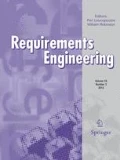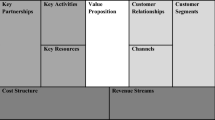Abstract
In market-driven software evolution, the objective of a requirements engineering process include the envisioning and fostering of new requirements on existing packaged software products in a way that ensures competitiveness in the marketplace. This paper describes an industrial, market-driven requirements engineering process which incorporates continuous requirements elicitation and prioritisation together with expert cost estimation as a basis for release planning. The company has gained a measurable improvement in delivery precision and product quality of their packaged software. The described process will act as a baseline against which promising new techniques can be evaluated in the continuation of the improvement programme.
Similar content being viewed by others
References
Specification and Description Language (SDL). ITU-T Standard Z. 100. International Telecommunication Union, 1992
Message Sequence Chart (MSC). ITU-T Recommendation Z. 120. International Telecommunication Union, 1996
Tree and Tabular Combined Notation (TTCN). ISO/IEC Recommendation 9646-3. International Standardization Organization, 1992
Fowler M, Scott K. UML distilled: applying the standard object modelling language. Addison-Wesley, Reading, MA, 1997
Shaw M, Garlan D. Software architecture: perspectives on an emerging discipline. Prentice-Hall, Englewood Cliffs, NJ, 1996
Sommerville I, Sawyer P. Requirements engineering: a good practice guide. Wiley, New York, 1997
Humphrey WS. Managing the software process. Addison-Wesley, Reading, MA, 1989
Regnell B, Andersson M, Bergstrand J. A hierarchical use case model with graphical representation. In: IEEE international symposium and workshop on engineering of computer-based systems, Germany, March 1996
Wohlin C, Gustavsson A, Höst M, Mattsson C. A framework for technology introduction in software organizations. In: International conference on software process improvement, Brighton, UK, 1996
Regnell B, Kimbler K, Wesslén A. Improving the use case driven approach to requirements engineering. In: IEEE second international symposium on requirements engineering, York, UK, March 1995
Regnell B. Hierarchical use case modelling for requirements engineering. Licentiate thesis no. 120, Department of Communication Systems, Lund University, Sweden, 1996
Karlsson J, Ryan K. A cost-value approach for prioritizing requirements. IEEE Software 1997; September/October
Karlsson J. A systematic approach for prioritizing software requirements. Doctoral disertation no. 526, Dept. of Computer and Information Science, Linköping University, Sweden, 1998
Author information
Authors and Affiliations
Corresponding author
Rights and permissions
About this article
Cite this article
Regnell, B., Beremark, P. & Eklundh, O. A market-driven requirements engineering process: Results from an industrial process improvement programme. Requirements Eng 3, 121–129 (1998). https://doi.org/10.1007/BF02919972
Issue Date:
DOI: https://doi.org/10.1007/BF02919972




